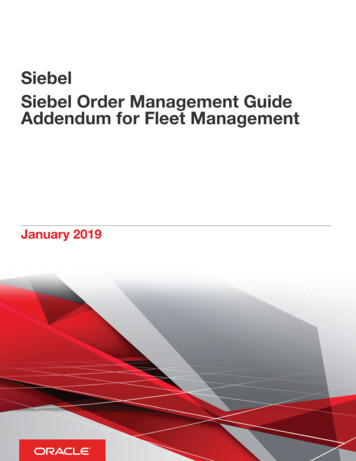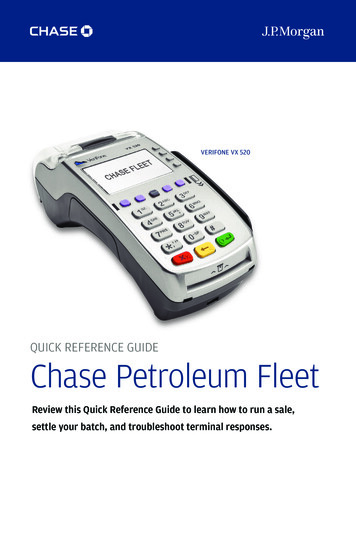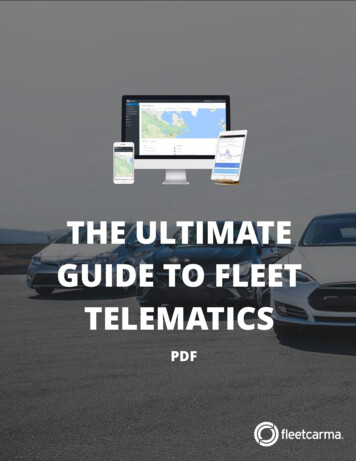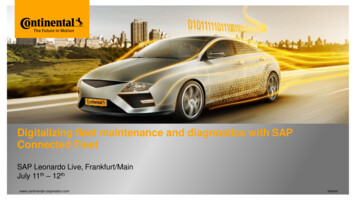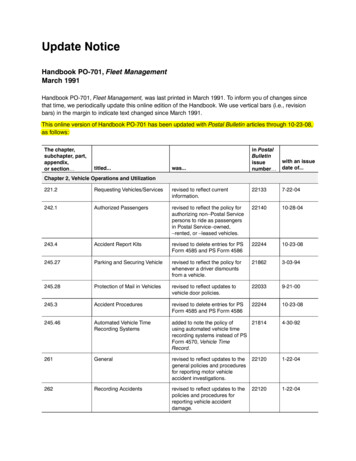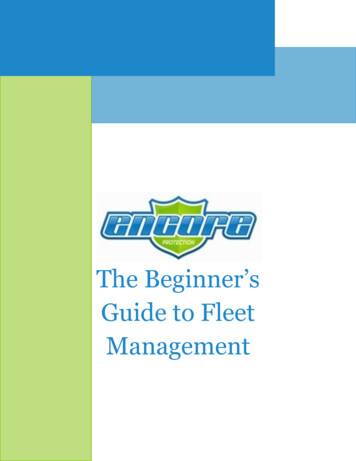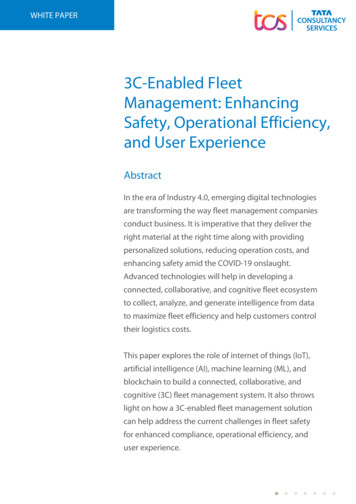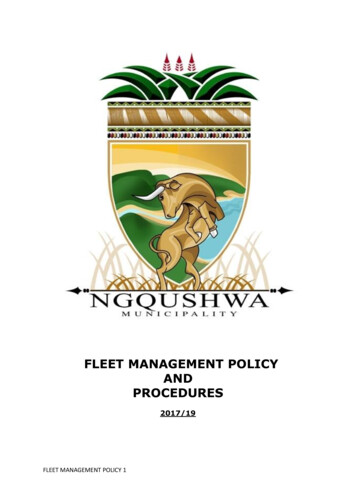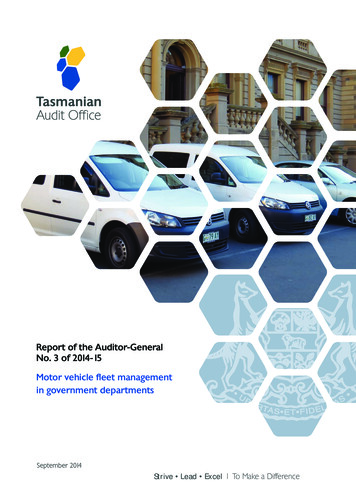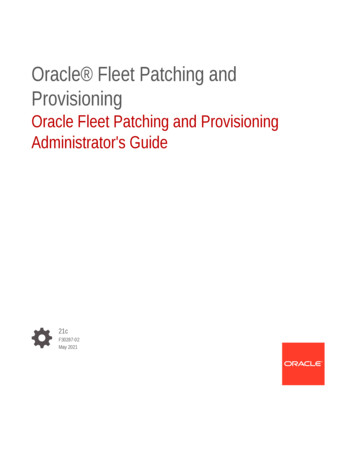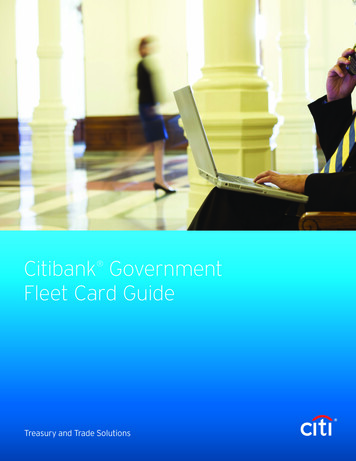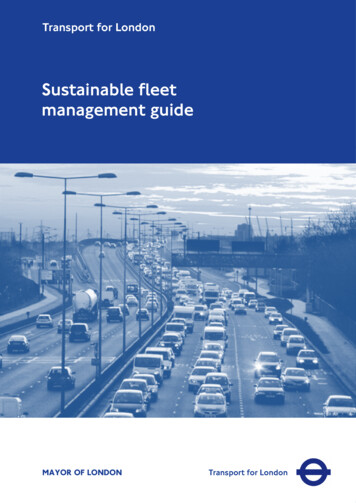
Transcription
Transport for LondonSustainable fleetmanagement guideMAYOR OF LONDONTransport for London
ContentsForeword . 31.Introduction . 4What is the guide? . 4Who this guide is for? . 4Why is it important? . 4How to use this guide . 52.Developing a sustainable fleet management strategy . 7Principles of sustainable fleet management . 7The sustainable fleet management process . 9Stage 1 Assessing current performance . 93.Vehicles and the environment . 14Air quality . 14Climate change and carbon emissions . 154.Managing mileage and fuel . 17Step1 Monitoring and setting targets . 18Step 2 Managing and reducing mileage . 21Step 3 Managing and improving fuel efficiency . 255.Vehicle and fuel technology . 29Latest technology petrol and diesel vehicles . 29Electric and hybrid vehicles . 30Gas vehicles . 33Biofuels . 34Future technologies . 36Comparing the technologies . 366.Choosing a fleet . 38Assessing the options . 40Incentives to help make the switch . 40Incentives for staff to use the preferred vehicles. 41Page 2 of 46
ForewordAdvances in vehicle technology, communications systems and managementtechniques provide us with a great opportunity to develop a transport networkthat is sustainable and adaptable to the demands of the 21st century, withimproved journey time reliability, fewer accidents, reduced congestion and abetter environment.Fleet managers have a pivotal role in delivering these benefits. As majorpurchasers of new vehicles you are central to the adoption of newer, cleanertechnologies into the vehicle fleet. As coordinators of business travel,deliveries and services you can help to improve vehicle use, reducecongestion, improve journey time reliability and save your business money. Asproviders of driver training you can also improve safety, while reducingemissions and saving fuel.This guide is intended to assist with the process of implementing sustainablefleet management, and help identify current strengths and weaknesses, andpriority areas for improvement. It has a particular focus on cleaner fuels andtechnologies, and how to select those best suited to individual operationalneeds.In 2012, along with many European cities, parts of London still do not meet EUtargets for the most harmful pollutants affecting health and everyday quality oflife, and further reductions in emissions from road transport will have to beachieved. The measures described in this guide will help the fleet industry playits part in delivering these improvements while achieving benefits for a rangeof businesses, including: Reduced fuel and vehicle costs Improved operational performance Money and time savings through more efficient travel policies and practices Reduced emissions that contribute to air quality and climate change Improved reputation which, in turn, can lead to competitive advantageClearly, there is no one-size-fits-all solution. Different solutions will benefitsome employers more than others, but there are very real savings to be madeas shown by the examples in this guide. By working together we believe wecan positively influence the transport choices made and deliver a fit forpurpose solution that will reduce the impacts of your fleet on your bottom lineand the environment.Iain MacbethBusiness Engagement Programme ManagerPage 3 of 46
1. IntroductionWhat is the guide?This guide provides practical advice to fleet managers on how to implementsustainable fleet management practices that contribute to environmentaltargets and reduce transport costs. This guide illustrates how a sustainablymanaged fleet can: Minimise fuel costs and optimise carbon dioxide (CO2) based tax liabilities Adopt efficient journey planning techniques to reduce mileage, minimiseexposure to congestion and make more efficient use of company transport Adopt new, low emission, vehicle technologies and fuels that are mostappropriate for individual business needs Reduce accidents and associated risks and costs through improved driverperformance, and provide a safer fleet as part of health and safetyresponsibilities Support corporate sustainability goals, for example, under ISO 14001 andother environmental reporting requirements Provide a competitive edge by demonstrating environment credentials in amarket where these are becoming increasingly important to clientsWho this guide is forThis guide is designed to help those who have managerial or financial controlover a fleet of vehicles. This could range from the fleet manager to thecompany secretary, department secretary or facilities manager. It will proveparticularly helpful to those organisations with fleets of light duty vehicles (carsand vans).Why is it important?Fleet vehicles are an essential part of the transport system and vital tosuccessful business operations. However, fleet operators are under growingpressure from rising fuel costs, congestion and the need to reduceenvironmental impacts. The need to meet national targets for reductions ingreenhouse gas (GHG) emissions from commercial vehicles requires furtherefficiency improvements as poor air quality continues to be a problem in urbanareas like London requiring measures such as the Low Emission Zone (LEZ).The advice in this guide can therefore help your business respond to: Rising fuel costs Compliance with environmental regulations and emission-basedrestrictions on vehicles such as the LEZ Increased pressure on employers to take responsibility for the health andsafety of employees while driving on company businessPage 4 of 46
Meeting the requirements of environmental management systems, forexample, ISO 14001 Demands from customers for improved environmental performance andreporting Up to one in three road crashes involves a vehicle being drivenfor work Every week, this results in around 200 work-related deaths or seriousinjuries For the majority of people the most dangerous thing they do at work isdrive on the public highwayDepartment for Transport (DfT)www.drivingforbetterbusiness.comHow to use this guideThe remainder of this guide provides information and advice on how toimplement the principles of sustainable fleet management. Section 2 describes the basic principles and processes of establishing asustainable fleet management strategy Section 3 provides an overview of the main environmental impacts ofvehicles Section 4 describes the methods for managing vehicle fuel and mileage Section 5 describes the vehicle and fuel technologies available to helpreduce emissions Section 6 describes how procurement processes can be adapted toimprove the environmental performance of the vehicle fleetAdditional information and tools are available on the Transport for London(TfL) website at tfl.gov.uk/businessoffersSome of the topics mentioned in this guide are covered in more detail in otherTfL guidance, in particular: Smarter Working Sustainable business travelIn addition, TfL’s Freight Operator Recognition Scheme (FORS) and itsassociated freight micro-site provides advice for operators of light and heavygoods vehicles at tfl.gov.uk/forsAppendix 2 provides additional sources of guidance on the topics discussed.Page 5 of 46
Corporate environmental reportingAn increasing number of organisations are publishing environmental dataalongside financial data as part of their corporate reporting process in annualreports and environmental statements. This is being driven by shareholders,suppliers and customers demanding greater openness on the environmentalimpact of business, and is an aspect of lending criteria by financiers.Climate change and GHG emissions are a key reporting area forenvironmental management systems and many organisations are reportingcarbon footprints of their products for the benefit of consumers and whole lifereporting costs. Transport emissions are generally a significant element ofthese carbon footprints.More information on environmental and GHG reporting can be found atwww.defra.gov.ukPage 6 of 46
2.Developing a sustainable fleet management strategyPrinciples of sustainable fleet managementA sustainable fleet management strategy is one that aims to reduceenvironmental impacts through a combination of cleaner vehicles and fuels,fuel-efficient operation and driving; and by reducing the amount of road trafficit generates. In doing so the fleet minimises fuel and vehicle costs andimproves the safety and the welfare of employees while reducing its exposureto the problems of congestion.The strategy will also help you to meet the requirements of other policieswithin your organisation; for example, business efficiency, health and safety,equalities and inclusion, and corporate social responsibility (CSR).Increasingly, businesses are measuring and reporting their carbon emissions,including those arising from their transport activity known as Scope 3emissions. This is discussed in more detail later in the guide.A sustainable fleet strategy is based on three key types of measure: Transport demand management – aim to reduce the miles driven. Lookat whether trips are necessary, and consider if they can be combined andwhether the optimum routes are being used. By examining currentpractices, significant mileage savings can be made, thereby reducing fueland mileage costs, emissions and even the size of a fleet Cleaner fuels and technologies – aim to use the lowest emissionvehicles appropriate to their role. With existing diesel and petrol vehicles,use the smallest, most efficient vehicle appropriate for the job. Explorenew, low emission technologies such as electric vehicles (EVs) orsustainably produced biofuels that may be suitable Efficient vehicle use – ensure that vehicles are being used as efficientlyas possible and using the least amount of fuel. The key areas here aredriver performance and vehicle maintenance, as both have a significantimpact on fuel. Reducing fuel use will cut emissions and running costsPage 7 of 46
Central to sustainable fleet management is the principle that ‘you can’tmanage what you don’t measure’. The different measures are all based uponongoing monitoring and target setting to ensure that performance is assessedand continuously improved, as illustrated in Figure 1.Transport demandmanagementMonitoring andtarget settingOptimise operationsand vehicle useProcure efficient andlow emission vehiclesFigure 1: Transport demand managementSustainable fleet management has implications for many areas of businessmanagement, for example: Vehicle procurement and specification Business travel policies Company car allocation policies Heath, safety and environmental policies Logistics management Supply chain management and distribution Management and scheduling of sales staff, service calls etcPage 8 of 46
The sustainable fleet management processThe process of establishing a sustainable fleet management strategy issummarised in Figure 2.Stage Assess current performance1Stage Define business needs2Stage Identify opportunties for improvements3Stage Gain business and individual buy-in4Stage Implementation5Stage Ongoing monitoring and review6Figure 1: Stages in developing a sustainable fleet strategyStage 1 Assessing current performanceThe first stage in developing the strategy is to gain a thorough understandingof current fleet operations and costs, existing business policies and processes.This stage ensures you have the data to develop an informed fleet strategy.The sustainable fleet management checklist in Appendix 1 provides a simpletemplate to take you through the process of information gathering under thefollowing areas: What existing fleet policies do you have? What monitoring do you undertake? What measures do you undertake to minimise vehicle mileage? What do you do to encourage fuel efficient vehicle use? What do you do to ensure you use the cleanest and most efficient vehiclesand fuels?Working through the checklist can help identify those actions that are alreadybeing taken and potential opportunities for further improvement.Page 9 of 46
Stage 2 Defining business needs and prioritiesTransport is usually considered a ‘derived demand’, driven by the need to fulfilother objectives rather than being desired in itself. The sustainable fleetstrategy delivers cost savings by ensuring that your businesses needs fortransport are still met, but more efficiently than before. This means that therequirements your organisation has of its fleet need to be clearly understoodand defined. When defining your requirements Table 1 provides examples ofthe issues to consider.Table 1: Defining business prioritiesIssue toconsiderTravelrequirementsInformation neededThings to considerWho needs to travel, forwhat purposes, when andhow often? What are typicaltravel distances?Can travel be replaced bytele or video conferencing?Are other modes practicableoptions for certain journeys?Could travel be bettercoordinated?Are EVs a possibility forsome journeys where rangeis ntsWhere are vehicles based?How are they scheduled?How far in advance is travelplanned? What availability isneeded? How much sparecapacity is needed? How isrefuelling managed?What types of vehicles areneeded most often?What sort of goods orequipment are routinelytransported? What are theirtypical weights, sizes? Arethere specialist handlingrequirements, or loadingequipment?Are vehicles appropriatelyspecified for typical loads, ienot necessarily all selectedon the basis of an occasionalmaximum load?What is the most efficientway to allocate them?Could charging or refuellingalternative fuelled or EVs befitted into current schedules?Does space required for gascylinder or battery allow roomfor intended loads?Page 10 of 46
TrafficconditionsWhat sort of locations dovehicles mostly operate in,eg in urban centres, thesuburbs, motorways?Which fuel/vehiclecombination is mostappropriate for thecircumstances, in terms ofemissions performance, airquality, fuel economy etc?Corporatepolicies andprioritiesWhat else does yourorganisation expect of itsfleet, eg cost savingtargets? Corporate image?Safety improvements? Thereview of business policiesundertaken in Stage 1 is keyto thisWhat are the implications forvehicle specification?What performance indicatorsdo you need to focus on?The environmental drivers for a vehicle fleet will be set by corporatesustainability priorities, operating location and legislation. Examples of driversand policies that will influence targets and priorities include:Table 2: Defining environmental prioritiesClimate changeAir qualityCorporate fuel use and carbonreduction targetsOperating within an Air QualityManagement AreaEnvironmental management andreporting systems such as the EcoManagement and Audit Scheme(EMAS) and ISO 14001Operating in the LEZReporting under national indicatorson carbon emissions or corporateenvironmental reportingEnvironmental management andreporting systems such as EMAS andISO 14001Understanding these will enable you to ensure that vehicles are fit for purposebut not over-specified; that unnecessary travel is not undertaken withoutcompromising service delivery; and that new technologies can deliver theirintended environmental benefits while still being suitable for your operationalrequirements, for example, in terms of range and carrying capacity.Page 11 of 46
Stage 3 Identify opportunities for improvementHaving collected information on current performance, and ensured that yourneeds are fully understood and defined, the next step is to look foropportunities for improvement.The first step is often to improve the systems for monitoring fuel costs andconsumption, and to manage and plan the need for travel. These aredescribed in more detail in Section 4. Very often, once an effectivemanagement system is in place, and employees become aware that fuel useis being monitored, then improvements will be seen straight away.Furthermore the performance indicators provided by good monitoring oftenpoint towards further areas where improvements can be made, for example,vehicles that perform poorly against expected miles per gallon (mpg), areunderused, or don’t meet expectations.Other areas where improvements can often be achieved include: Set targets and providing training for drivers (see Section 4) Introducing cleaner vehicles and technologies suitable for your operationalneeds (see Section 5) Improving vehicle specification processes (see Section 6) Ensuring that business policies and processes are aligned to support theobjectives of efficiency and sustainability, for example, making sure thereare no perverse incentives not to reduce mileage such as mileagethresholds that have to be achieved in car allocation policiesIt is not possible to be prescriptive in how this process should be undertakenas the underlying principle of the strategy is to meet the individual needs of thebusiness. But, by taking a holistic review of everything the fleet does, startingwith a clear definition of what the business requires it to deliver, efficienciescan usually be identified.Stage 4 Gaining business buy-inTo successfully implement a sustainable fleet management review andstrategy high level business support is essential. This can be achieved bydeveloping the business case and explaining how the review and resultingmeasures can achieve corporate objectives. These benefits include: Reduced operating costs gained through a reduction in miles, vehicleoperating costs and improved employee productivity Delivering carbon reduction and other environmental impacts, alleviatingthe reliance on fossil fuels, improving business resilience, improvingorganisational accessibility to new workforce and fostering good CSR Enhancing the organisation’s image and environmental managementcredentials which can result in increased sales and improved contractPage 12 of 46
tendering process; improving financial reporting processes; andenvironmental reporting of CO2 impact to clients and supply chainMuch of sustainable fleet management is simply good business practice, socan be justified on its own commercial merits. Improving fleet performance onpurely commercial or cost efficiency grounds almost always involves betterfuel economy and lower emissions, so the environmental gains are a bonus.In many cases, environmental factors such as the LEZ in London can form theideal stimulus to review a fleet policy and examine the improvements that canbe made.Once senior management has signified support of the programme this willenable you to formulate an appropriate strategy for review and later acommunications plan for engagement with the wider workforce. Thisengagement, whether one-on-one or within focus groups will enable you todeliver a solution that is practical and fit for purpose.Stage 5 ImplementationImplementation of the strategy involves putting into practice the measuresidentified in the earlier stages. The rest of this guide provides detailedguidance on individual measures that might be included, for example, TfL’sFORS programme and freight micro-site. See Appendix 2 for a longer list.All of the solutions outlined are likely to need tailoring to your organisation’sbusiness requirements to achieve the best outcomes.Stage 6 Ongoing monitoring and reviewThe fleet management strategy should be a living document, regularlyreviewed and updated in the light of changing requirements and newexperience. The monitoring processes that are central to sustainable fleetmanagement will help you identify where the opportunities for future savingslie, and will also show which cost saving measures prove most effective, soyou can decide whether to continue or change your approach.Key elements that should be reviewed are: Periodic review and revision of the fleet checklist Review business needs and drivers, for example, to take account of anychanges in customer requirements, or new legislation or regulation Review your monitoring and data collection processes: are they providingthe information you need? Are administrative costs acceptable? Ensure regular reviews of performance of new vehicles, or newtechnologies that have been trialled, to ensure they are meetingexpectations and are appropriate for your business needsPage 13 of 46
3. Vehicles and the environmentRoad vehicles are likely to be a key element of an organisation’s transportrequirements. However, the reliance of these vehicles on fossil fuels such aspetrol and diesel gives rise to poor air quality and the associated healthimpact, and carbon emissions which contribute to climate change. Vehiclesalso contribute to noise pollution, which can affect people’s health and qualityof life.Air qualityReducing pollution from traffic is one of the top public priorities in terms ofimproving the quality of the environment according to the Greater LondonAuthority’s (GLA’s) Annual London Survey 2011 1.The key environmental concerns are: Nitrogen oxides (NOx), the generic term for nitric oxide (NO) and nitrogendioxide (NO2), are formed by a reaction between nitrogen and oxygengases in the air during combustion. Further reactions of NOx with otheratmospheric factors can lead to the formation of other pollutants such asozone and acid rain Fine particles, referred to as particulate matter or PM10 and PM2.5. Roadtraffic is the greatest contributor to these as a result of engine emissionsand tyre and brake wear. A study for the GLA estimated that fine particlescould be involved in more than 4,000 deaths in London each year2Boris Johnson, Mayor of London published his Air Quality Strategy (MAQS) in2010, with the overarching aim of reducing air pollution in London. Thestrategy incorporates policies and proposals for improving air quality andmeasures include the reduction of vehicle emissions by encouragingsustainable travel behaviour. By working in partnership with employers andfleet managers, our joint actions can make a real difference, and evenrelatively small changes can have positive impacts on business profitability,the environment and air quality.1Annual London Survey, 2011 Greater London Authority,2Report on estimation of mortality impacts of particulate air pollution in London, Dr Brian G Miller,GLA, 2010Page 14 of 46
The key theme of the MAQS that relate to transport and businesses are: Encouraging sustainable travel behaviours such as walking and cycling,smarter driving Promoting technological change and cleaner (low emission) vehicles Retrofitting existing vehicles with particulate traps Tackling specific pollution hotspots and improving air quality through apackage of local measures Reducing emissions from the public transport fleet with low emission buses Emissions control schemes such as additions to the LEZ and ‘no engineidling’ enforcementIn terms of low emission vehicles, the strategy is encouraging businesses touse vehicles with more stringent Euro emission standards and adopt newtechnologies such as EVs.The LEZ is one of the primary air quality mechanisms reducing emissions fromheavier vehicles in London. Currently, heavy goods vehicles (HGVs), busesand coaches are required to meet an agreed standard (Euro III standard forPM) to drive within the LEZ without charge. From 3 January 2012enhancements were made to the scheme, including increasing the standardfor HGVs, buses and coaches to Euro IV and expanding the scheme toinclude larger vans, minibuses and other specialist diesel vehicles which willhave to meet the Euro III standard. To find out what vehicles are affected bythe LEZ, visit www.tfl.gov.uk/roadusers/lez/Climate change and carbon emissionsScientific consensus is that climate change is driven by increases in manmade GHG emissions, of which CO2 is the most dominant 3. Transportcurrently accounts for 22 per cent of total CO2 emissions in London, and 72per cent of this is from road traffic. 4To reduce the impact of climate change it has been estimated that there needsto be a reduction in global emissions of at least 50 per cent on 1990 levels by2050 5. The UK Government has acted upon this by setting itself a legallybinding target of an 80 per cent cut by 2050, with an interim target of a 34 percent cut by 2020. Individual businesses are contributing towards these targetsby setting their own targets for reduction and reporting their carbon emissions,for example, the Scope 3 emissions that include business transport. Many3The other important ones are methane (CH4) and nitrous oxide (N2O).4Mayor’s Transport Strategy (May 2010)5See Intergovernmental panel on climate change reports http://ipcc.ch/Page 15 of 46
organisations now require their suppliers to undertake carbon reporting as partof their procurement policies.In London, the Mayor has set out a climate change mitigation and energystrategy 6 that has even more challenging targets with a 60 per cent cut incarbon emissions by 2025, just 15 years away. The strategy considers there tobe a major economic opportunity for London businesses through lower fuelcosts, increased competitiveness and new jobs in low carbon businesses.The key transport themes in the strategy reflect those in this guide: to reducethe need to travel, improve the efficiency of transport through better drivingstyles, and the adoption of low or zero carbon technologies. The approach tohelping reduce carbon emissions in London includes: Improving the efficiency of the transport system by supporting smarterdriving, encouraging participation in FORS (www.fors-online.org.uk) andimproved traffic management schemes Promoting low carbon vehicles with a key target of more than 1,000 chargepoints in London by 2013, linking parking charges to carbon emissions,and all new buses to be hybrid from 2012The UK Low Carbon Transition PlanThe Government has set out a range of policies that it is implementing to helpreach its carbon targets. A number of these are targeted at car and van fleetsand include: Requiring the use of 10 per cent biofuel in road transport fuel by 2020 EU new car CO2 regulations of 130 grams per kilometre (g/km) by 2015 and95g/km by 2020 for the production average, compared to the currentaverage of around 150g/km Proposed EU new van CO2 regulations with draft standards of 175g/km by2012 and 160g/km by 2015 for the production average, compared to currentlevels of around 268g/kmFor more information visit the Department of Energy and ClimateChange (DECC) website at www.decc.gov.uk6‘Delivering London’s Energy Future: The Mayor’s climate change mitigation and energy strategy(November 2011)Page 16 of 46
4.Managing mileage and fuelManaging the fuel use and mileage of a fleet is fundamental to successfulsustainable fleet management. Whatever the type of vehicles you operate, ifthey are badly driven, poorly maintained and used unnecessarily, then anybenefits of cleaner technology will be negated.Fuel contributes 20-30 per cent to a vehicle’s whole life costs. This is not afixed overhead that has to be accepted, it is a controllable cost that variesaccording to vehicle type, driving style, vehicle maintenance and mileage.Fleets that have implemented fuel efficiency programmes often achievesavings in fuel costs of 10 per cent or more, so, for many organisations theadditional staff cost involved is easily paid back.This section of the guide goes through the options for reducing the mileagedriven by vehicles and improving their fuel efficiency through the followingsteps:Step 1 Monitoring and setting targets How to monitor mileage How to collect and monitor fuel data Setting performance improvement targetsStep 2 Managing and reducing mileage Reducing business travel and managing the grey fleet,employee owned vehicles used for work journeys Pushing down fleet vehicle mileageStep 3 Managing and improving fuel efficiency Improving driver performance Good vehicle maintenancePage 17 of 46
Step1 Monitoring and setting targetsIt is only by monitoring fuel consumption and mileage that an organisation canunderstand where and how fuel is being used and what mileage is takingplace, and so identify where savings can be made.How to monitor mileageThe starting point is to understand a fleet’s mileage patterns and thencompare this with identified business or operational requirements. This willen
The sustainable fleet management process The process of establishing a sustainable fleet management strategy is summarised in . Figure 2. Figure 1: Stages in developing a sustainable fleet strategy . Stage 1 Assessing current performance The first stage in de
